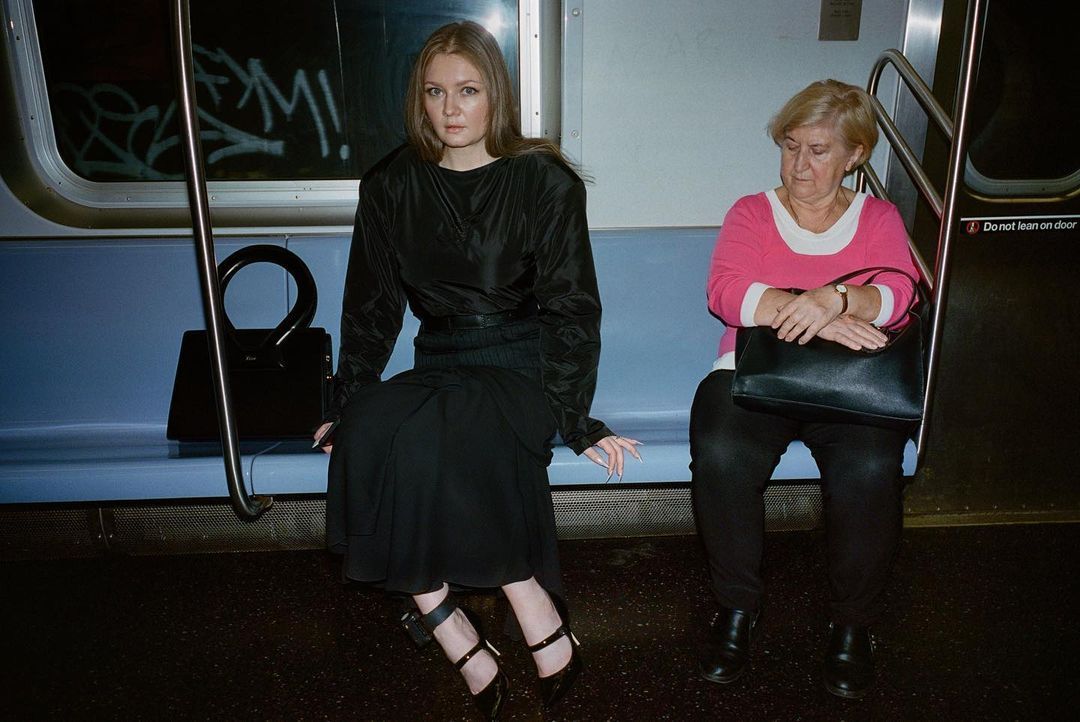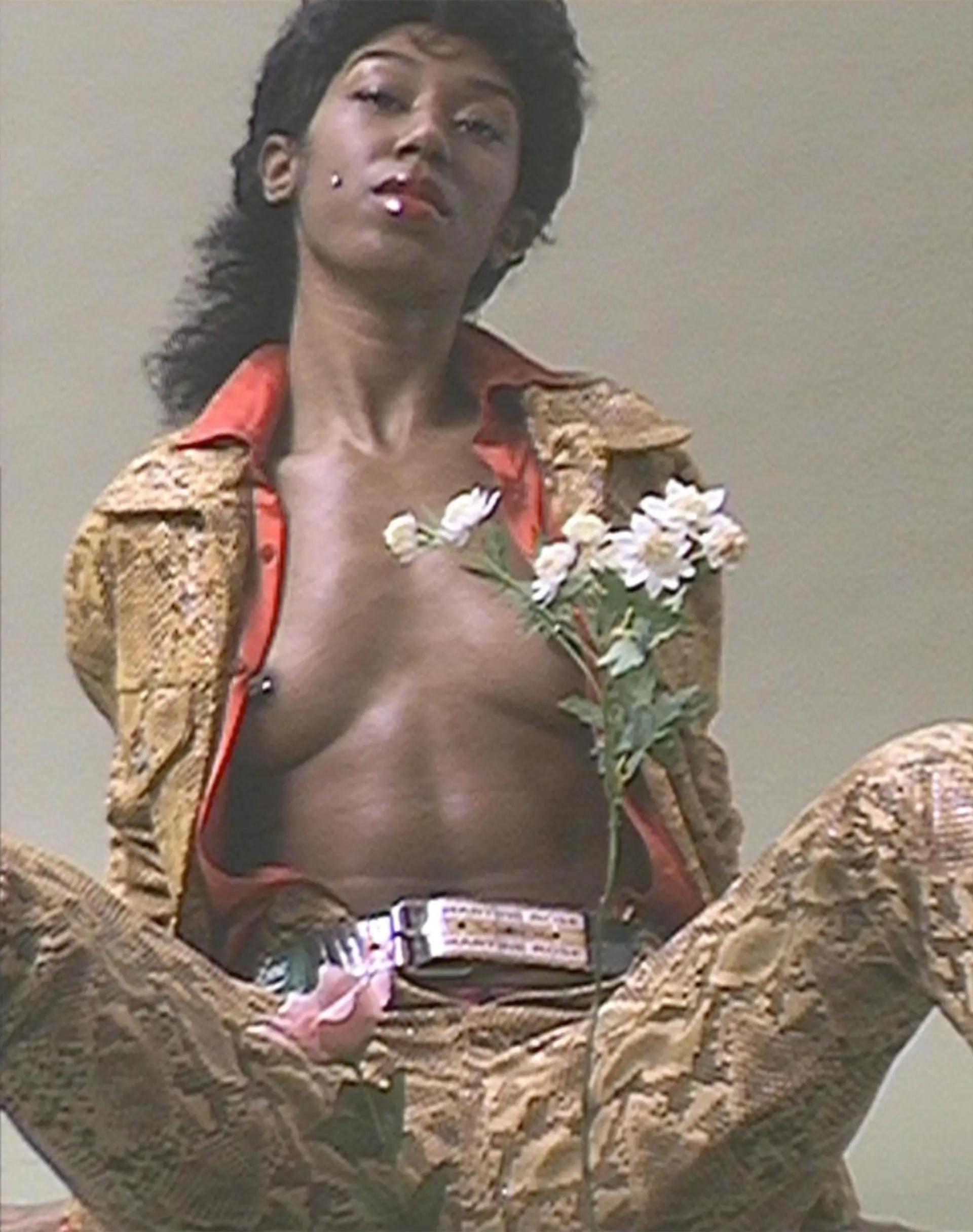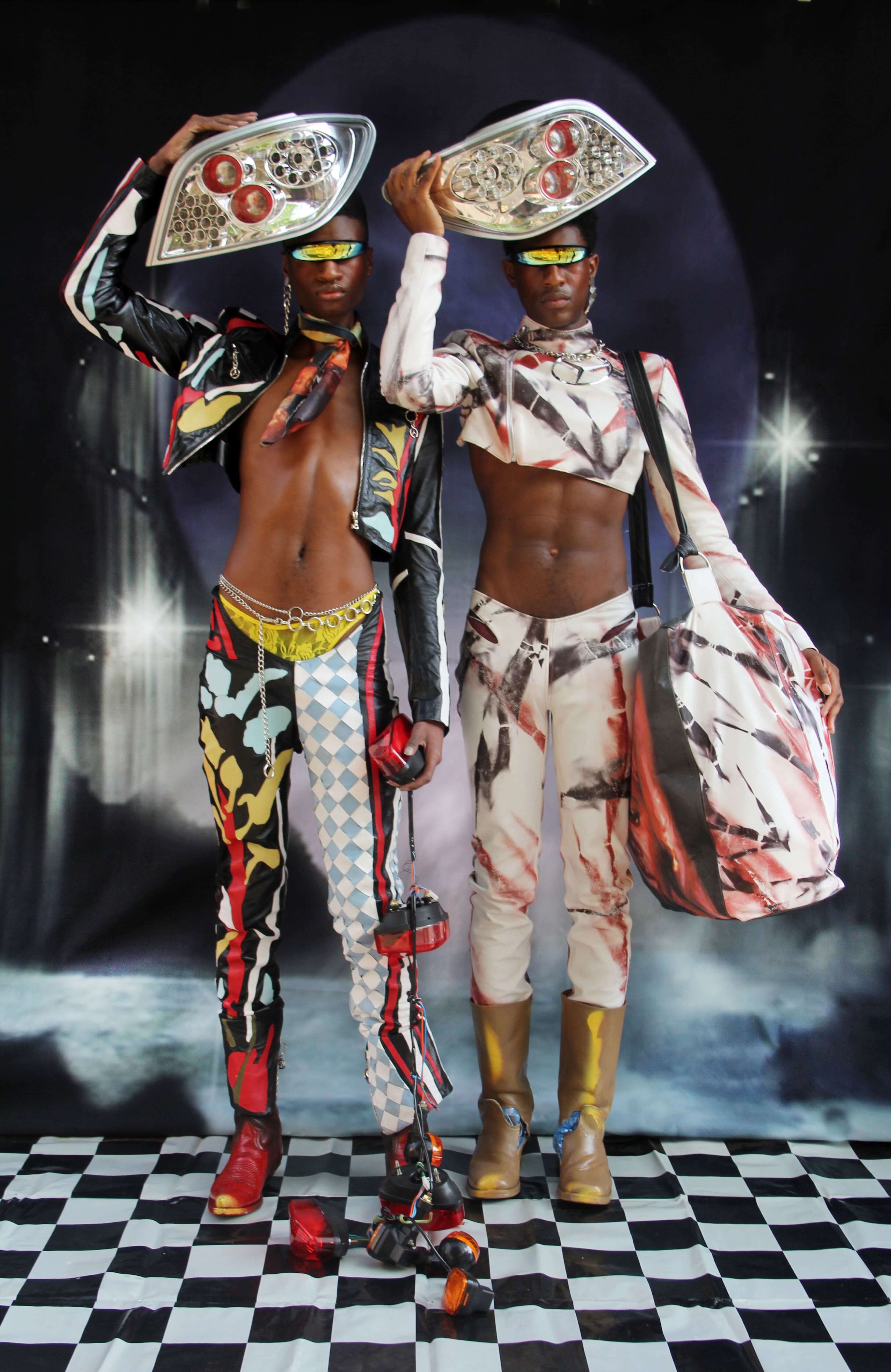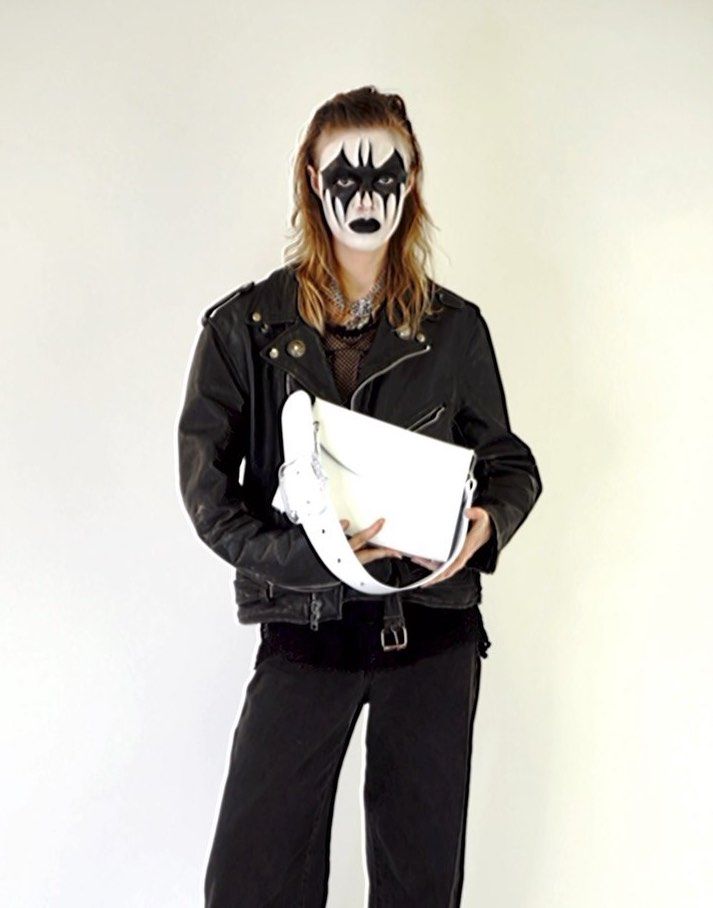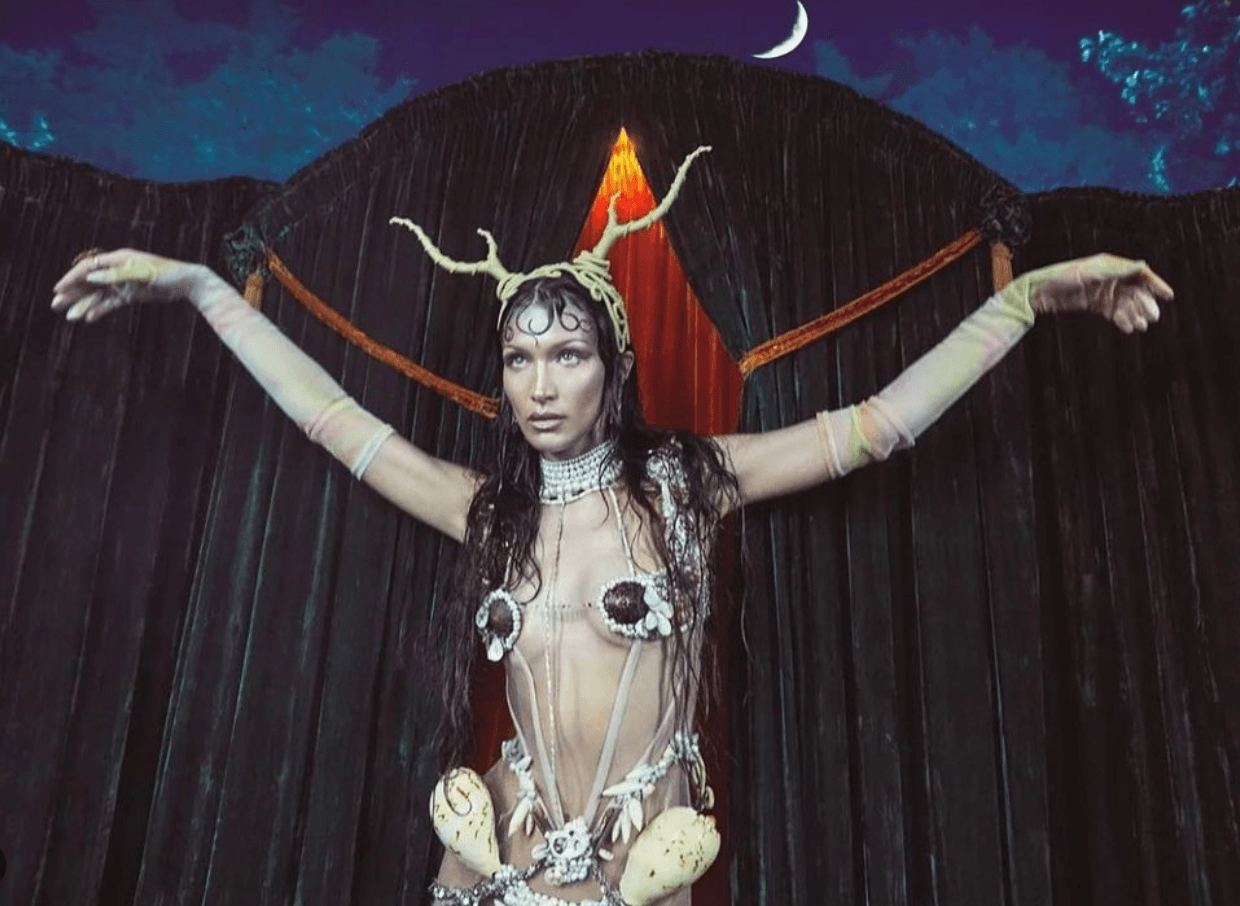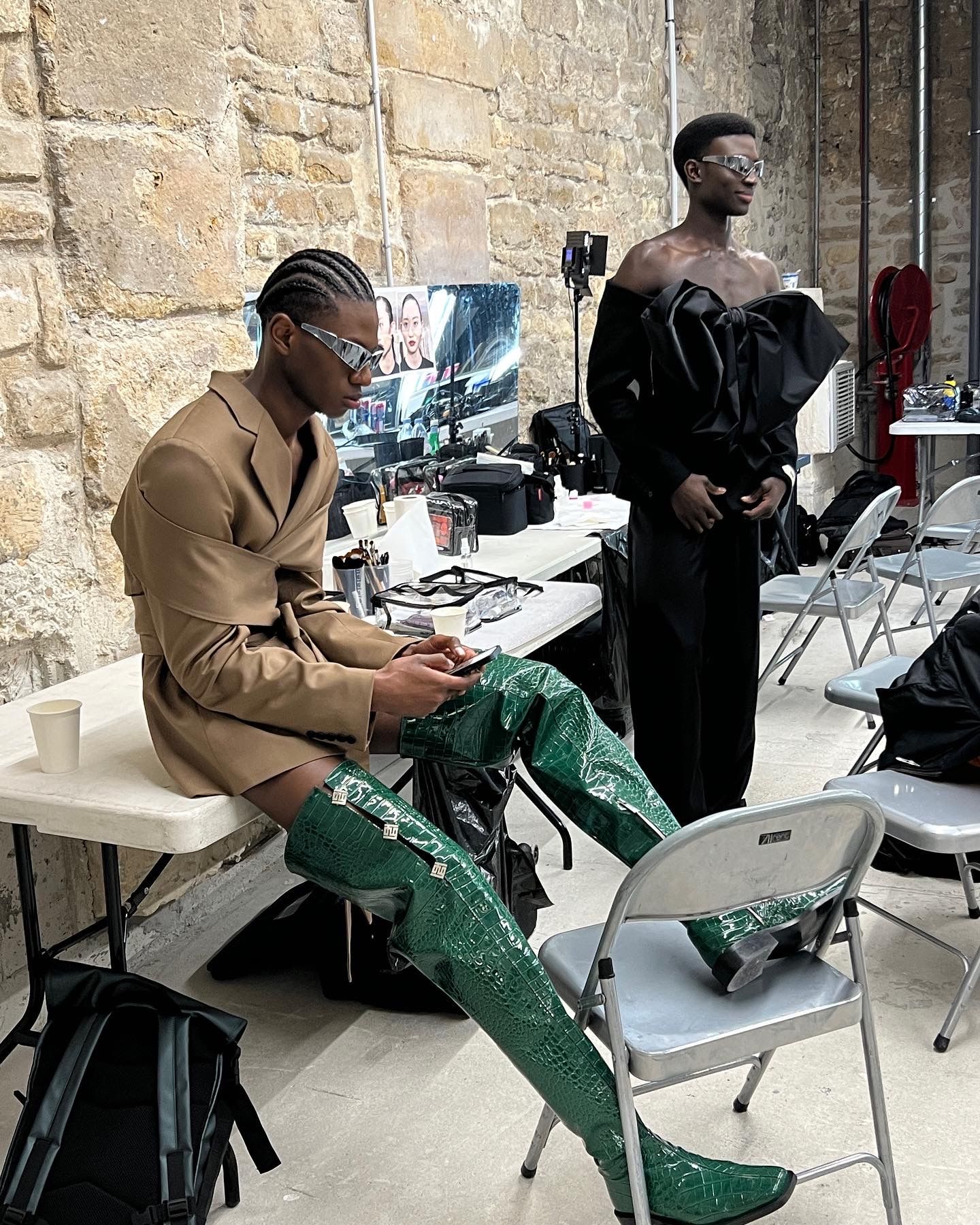Barragán for Dummies
|PHILLIP PYLE

For all its taboo image pairings—ranging from Christ and syringes to religious habits and anal beads—which often test the threshold of public outrage, the only technically illegal element of Barragán’s Spring/Summer 2024 show was its use of the Mexican flag in tiny details of a few of the collection looks. However, it was not the show’s inclusion of a symbol strictly prohibited from commercial or apparel usage in Mexico, but its controversial setting at a militarized airport outside Mexico City that made it a hot topic amongst local and national news outlets.

Titled “Quiet Luxury,” SS-24 was staged at Felipe Ángeles International Airport during the middle of the fashion calendar and included everything from sexified camouflage and national flag assemblage prints to reimagined costumes for the matador, the fencer, and the revolutionary fighter. The collection revolved discreetly around a look featuring Victor Barragán—the Mexico City-born, New York City-based brand founder and artist—walking his own runway as Charles Manson in handcuffs, complete with a crucifix pendant welded from syringes. With Barragán serving as the cult leader of a show rife with seemingly divergent religious symbolisms (Star and crescent, Star of David, and the Christian cross), cheeky graphic t-shirts illustrating that bullet “size does matter,” parodic 2000 Al Gore campaign merch, and military-inspired pieces—paired with everything from pink biker shots, to Blair Witch Project-inspired “Twana” necklaces and a gold foil top that says “Made in China”—it’s only fitting that the show was capped by a hybrid priest-nun missionary looking ready to convert us while carrying a “Barragán for Dummies" book.


The “Quiet Luxury" show took issues with many things: The bloody impact of American imperialism and neoliberal policies abroad, the symbolic excess and physical labor off-shored by ever-quickening trends cycles in Europe and America, and the hyperbolic narco-propaganda used to dispel the much more complex usage of drug paraphernalia today. Through the sheer breadth of its subject matter, the show also marked a new height for Barragán’s conceptual prowess—a development as influenced by the designer's commitment to fun (no matter how serious the subject) as it is by years of practice and fine-tuning.
Phillip Pyle talked to the designer and artist about Barragán’s last two runway shows, why the syringe signifies more than just drug usage, and how his “spiritual era” is dictating things—including a special release set to coincide with “Great North American Eclipse” on Monday, April 8.

PHILLIP PYLE: You opted out of the official fashion calendar after your SS-23 show. Your first show since then, “Quiet Luxury,” was staged at an airport in Mexico on the last day of Paris Women’s Fashion Week.
VICTOR BARRAGÁN: My idea was to do it in Mexico but not in Mexico at the same time. I was intending to do the show at the Mexican embassy in Berlin— legally, the embassy is Mexico although it’s in Europe—but the production was over my budget.
Then, after asking a lot about the new airport [Felipe Ángeles International Airport] in Mexico City, I thought it would be amazing. I can’t believe it happened; it was kind of meant to be. We canceled the show in Berlin, and then brought the whole energy to Mexico City. The bureaucracy process was arduous because the Mexican military controls the airport. We tried to explain the ideas to them and they didn’t get it. Obviously, we didn’t show any of the clothes until after we signed the contract. The main gag was: How are we going to show all these prohibited items at the airport? The only illegal thing we did was use Mexican flags. That’s the only thing that they were pissed about after.




PP: The airport was originally built for the Air Force and opened to civilians two years ago. How did the militarized history of the venue interact with the nationalist, religious, and more traditional imagery and references that were in the show?
VB: After the show, the main guy who controls the airport was like, “Can you explain to the military people what’s going on?” They thought it was about gay people dressing how they want to dress. I had to laugh because they didn’t pay attention to so many of the details—the only thing that was crazy for them was the flag. The rest was like, “Oh, whatever!” It was on the news in Mexico and in all the newspapers because this airport has a really bad reputation due to its associations with the new president [Andrés Manuel López Obrador]. It’s a meme throughout the country, so it’s quite funny how the show was received in the media. I was really happy with the result.
PP: So, they didn’t have any issue with the syringes and Jesus paraphernalia?
VB: Well, that was quite complicated. The airport is one and a half hours away from the city, and they’re still building a transportation system so people can actually go there. We had to rent five huge buses to bring people to the airport. Then the question was: How we are going to get people through TSA without a boarding ticket? We had to have a list, a specific sticker, and lead people to this specific part of the airport. When we got there to prep, we had to go through all the items in TSA. We were so overwhelmed because we had so many syringes, things that were spiked, fake bullets. We had to explain that this is not a bullet, this is a plastic… blah, blah, blah.


PP: The show had all these bloody or violent elements. There’s the bullet hole forehead ornament and the cooler for organs. But some of the objects are also associated with pleasure: the GHB dose timing belts, spiked bondage underwear, and syringes.
VB: Syringes are not exactly about pleasure. People think you mean drugs, obviously. But so many people have a different relationship with syringes. A lot of my trans friends were like, “Oh, hormones.” People that are diabetic think about insulin. In the crucifix-syringe, we have three different liquids. So, we're talking about three different substances we can put in our body. The idea has to do with how we modify our bodies, right now, to be healthy. The idea is: how can that item unify us?

PP: I was thinking about a similar dynamic with the use of the cross on the forehead. The Charles Manson moment is obviously a nod to the cultish element, but there are also connotations of Christ’s stigmata and the ashes that you get on Ash Wednesday as a Catholic. Do you see the forehead mark as a similar symbol unifying divergent meanings?
VB: Definitely. In my work, I like to use a lot of pop culture references. With Charles Manson, I wanted to unify everyone in the show as if it were a cult. I just dragged myself into Charles Manson. I wasn’t going to do the swastika, I found that edge problematic. I wanted to put myself in the middle instead of at the end [of the show] because usually I don’t say goodbye or hi at the end. It’s a playful way to talk about all these really interesting, serious matters in a more approachable way.
PP: I’ve noticed the cultish editorial imagery for the graphic t-shirt releases. For the Heaven’s Gate t-shirt, you used these tourist images of a middle-aged man wearing the shirt. And then you photoshopped the Diablo t-shirt onto Billy Loomis from Scream. I’d like to hear more about the types of people that you feature in these editorials.
VB: I feel inspired by using specific moments of pop culture in a way that suggests, “if you know you know.” People who know Wes Craven, who love Scream (1996), they’ll know this scene. We used Funny Games (2007), too. I like to have this coded way of presenting ideas. And I know some people don’t like the imagery because it’s loud and crazy. Using all these scenes from movies or people—it’s a personal taste that I like to put out there. I like to mix it with what I’m doing at the moment. When people get the reference, we all kind of connect. My work is connecting dots with different people and different nostalgias.


PP: What about the AI imagery that’s not even related to the clothing? I’m thinking of the photo of women in front of the White House in a hammer and sickle shape.
VB: Mixing these ideas and putting it out there without using the clothes is more powerful to me because I’m not trying to sell you a t-shirt with this on it. It’s more about the idea. I pay attention to what we put out there, I’m not trying to offend people, but I know some people are not going to understand it. So that’s always a challenge. It’s the way I see my artworks, too. I put it out there, it takes some time, and I know sometimes the reception is going to be quite intense.
The idea [with the hammer and sickle AI images] was to use the symbols that we used in the show, but we’re not selling you the product, we’re showing its concept.


PP: In many ways, the “Quiet Luxury” show felt like the natural, globalized extension of the themes explored in SS-23. How do you see these two shows relating?
VB: For that show [SS-23], I was expressing that I was tired of being put in a box only because I’m Mexican and brown in a more emotional way. I’ve felt like that for a long time, and I was trying to find a way to joke about that: how the industry perceives people of color, and how they’re used as a token in fashion. The idea was to talk about America in this way and just cast white people on purpose. That was a pretty intense commentary and the beginning of a new phase of the brand. I don’t want to have an identity so attached to me. I want to have more freedom with my work. The clothes are more wearable now. It’s less couture and more something that has a conceptual meaning. First, we talked about the U.S., then how America effects the whole world with globalization and cultural merging. That’s how we got to SS-24.




PP: Your runways have always tested the boundaries between fashion and performance. You’ve had models push a rock down the runway like Sisyphus. You also work with rafa esparza a lot, who works between performance and visual art. I saw you designed a ticket stub for Art Basel with him. And then also worked on a t-shirt together recently.
VB: Yeah, we did it with a friend, Guadalupe Rosales, who runs Veteranas and Rucas. It’s an archive for Chicano culture in LA. We had talked about Chicano culture in 90s pop culture and how people were embracing it at the time—Gwen Stefani, Kim, and Kourtney, we love them all. People trash it because of cultural appropriation—but it means more than that. And, for them [Lupe and esparza], they grew up in in LA in that era and have seen how it has always inspired fashion and art but doesn't always get properly credited. Obviously, the idea was also perfect at this moment in time. And that’s why we were like, “let’s do this t-shirt.” We're not even going to put it online; we're just selling it at the gallery [Commonwealth and Council].
PP: There are also moments where you explicitly intersect your own art practice with the brand. Do you ever find yourself reluctant to collapse these worlds?
VB: It took me time to separate them and to know this is my art practice and this is Barragán. The brand has grown up so much that it is its own entity now. I’d like to separate them because Barragán is speaking to a bigger audience and its own world. But it’s hard to not mix them. I’m working in both worlds simultaneously. Sometimes they speak to each other, sometimes not. Let’s see how this will play out in the future because people always want to put you in a box: “You’re a designer” or “you’re an artist.” It’s always like that, so I’ve been thinking about how to separate them. I don’t want to be stuck in fashion anymore. More people understand that now, and even the industry is like, “Oh, he’s doing things his own crazy way.”




PP: With your spike objects, I was thinking about pain and pleasure, and also about spirituality in a way. In BDSM, the ability to turn a painful experience into a pleasurable one often requires endurance and reenactment. And with any experience of repression or trauma, one can find ways to cope with trauma and to transform it into pleasure. Do you ever find it difficult to transform experiences of pain without becoming addicted to that feeling of transformation?
VB: In my case, I grew up very Catholic. It took moving to the US from Mexico City to work on it personally. I try to use my work to change the meaning of trauma. I feel like that’s really liberating. That’s how we use religion, sex, homophobia, and everything else that I put in my work. I like to be in contact with negative experiences. That way I can change them and keep learning and growing. And I think many people can relate because they go through similar stuff. That’s when everything merges together. That’s the case with the crucifix and the “Faggot” t-shirt.
And going the way of the pleasure, I don’t quite get what you’re saying about becoming obsessed. There’s some hedonism, for sure. You’re going to get lost. It’s about exploring your mind and body. I’m always talking about the interaction with the body. That’s the deeper meaning of a lot of things that I do.


PP: Is the trenBolone workout set an example of a work that connects with the body in a more specific way?
VB: Yeah, because trenbolone is the most aggressive steroid people can use. It comes with ideas of body modification and how much pain you have to go through to look a certain type of way. The set [trenBolone] was made in concrete and we also put in the meaning of sacrifice in Hispanic culture, so there’s many layers to it. I think it also really depends on where you show the piece. For example, it was shown at Jardín 17, at Luis Barragán’s house in Mexico City, and it had a different meaning using the materials in Mexico. And now a collector has the set next to his pool in LA. It’s good to have the work speaking to different people in different times and in different places. That’s the beauty of it. People keep asking questions about it. That’s what keeps the piece alive.
PP: Are there any plans in the works?
VB: We’re going to release something on April 8 for the eclipse. I’m choosing all these really specific dates like they mean something. [Laughs] I’m in a spiritual era now.




Credits
- Text: PHILLIP PYLE
- Art Director: GUILLAUME BOUCHER

